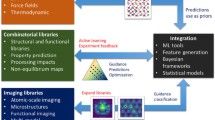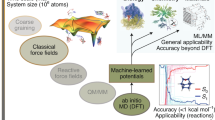Abstract
In the studies of materials, experimental measurements often serve as the reference to verify physics theory and modeling; while theory and modeling provide a fundamental understanding of the physics and principles behind. However, the interactions and cross validation between them have long been a challenge even to-date. Not only that inferring a physics model from experimental data is itself a difficult inverse problem, another major challenge is the orders-of-magnitude longer wall-clock time required to carry out high-fidelity computer modeling to match the timescale of experiments. We envisage that by combining high performance computing, data science, and edge computing technology, the current predicament can be alleviated, and a new paradigm of data-driven physics research will open up. For example, we can accelerate computer simulations by first performing the large-scale modeling on high performance computers and train a machine-learned surrogate model. This computationally inexpensive surrogate model can then be transferred to the computing units residing closely to the experimental facilities to perform high-fidelity simulations at a much higher throughout. The model will also be more amenable to analyzing and validating experimental observations in comparable time scales at a much lower computational cost. Further integration of these accelerated computer simulations with an outer machine learning loop can also inform and direct future experiments, while making the inverse problem of physics model inference more tractable. We will demonstrate a proof-of-concept by using a quantum Monte Carlo application, Dynamical Cluster Approximation (DCA++), to machine-learn a surrogate model and accelerate the study of quantum correlated materials.
This manuscript has been authored in part by UT-Battelle, LLC, under contract DE-AC05-00OR22725 with the US Department of Energy (DOE). The publisher acknowledges the US government license to provide public access under the DOE Public Access Plan (http://www.energy.gov/downloads/doe-public-access-plan).
Access this chapter
Tax calculation will be finalised at checkout
Purchases are for personal use only
Similar content being viewed by others
Notes
- 1.
The development of machine-learning and neural-network surrogate models to speed up QMC simulations is an active research area in condensed matter physics. The method and model described here is an ongoing research effort and will be published elsewhere upon completion.
References
Anaconda Data Science Package Manager. https://www.anaconda.com/
Balduzzi, G., et al.: Accelerating DCA++ (dynamical cluster approximation) scientific application on the summit supercomputer. In: 2019 28th International Conference on Parallel Architectures and Compilation Techniques (PACT), pp. 433–444 (2019)
Blankenbecler, R., Scalapino, D.J., Sugar, R.L.: Monte-Carlo calculations of coupled Boson-Fermion systems. Phys. Rev. D 24(8), 2278–2286 (1981)
dos Santos, R.R.: Introduction to quantum Monte Carlo simulations for fermionic systems. Braz. J. Phys. 33(1), 36–54 (2003)
Gull, E., Millis, A.J., Lichtenstein, A.I., Rubtsov, A.N., Troyer, M., Werner, P.: Continuous-time Monte Carlo methods for quantum impurity models. Rev. Mod. Phys. 83(2), 349–404 (2011)
Gull, E., et al.: Submatrix updates for the continuous-time auxiliary-field algorithm. Phys. Rev. B 83(7), 75122 (2011)
Gull, E., Werner, P., Parcollet, O., Troyer, M.: Continuous-time auxiliary-field Monte Carlo for quantum impurity models. Europhys. Lett. 82(5), 57003 (2008)
Hähner, U.R., et al.: DCA++: a software framework to solve correlated electron problems with modern quantum cluster methods. Comput. Phys. Commun. 246, 106709 (2020)
Hähner, U.R., Balduzzi, G., Doak, P.W., Maier, T.A., Solcà, R., Schulthess, T.C.: DCA++ project: sustainable and scalable development of a high-performance research code. IOP Conf. Ser. J. Phys. Conf. Ser. 1290(1), 12017 (2019)
Hettler, M.H., Tahvildar-Zadeh, A.N., Jarrell, M., Pruschke, T., Krishnamurthy, H.R.: Nonlocal dynamical correlations of strongly interacting electron systems. Phys. Rev. B 58(12), R7475–R7479 (1998)
Kotliar, G., Savrasov, S., Pálsson, G., Biroli, G.: Cellular dynamical mean field approach to strongly correlated systems. Phys. Rev. Lett. 87(18), 186401 (2001)
Laboratory Virtual Instrument Engineering Workbench (LabVIEW). https://www.ni.com/en-us/shop/labview.html
Lichtenstein, A., Katsnelson, M.: Antiferromagnetism and d-wave superconductivity in cuprates: a cluster dynamical mean-field theory. Phys. Rev. B 62(14), R9283–R9286 (2000)
Liu, J., Shen, H., Qi, Y., Meng, Z.Y., Fu, L.: Self-learning Monte Carlo method and cumulative update in fermion systems. Phys. Rev. B 95(24), 241104 (2017)
Mai, P., Balduzzi, G., Johnston, S., Maier, T.A.: Orbital structure of the effective pairing interaction in the high-temperature superconducting cuprates. NPJ Quantum Mater. 6, 26 (2021)
Mai, P., Balduzzi, G., Johnston, S., Maier, T.A.: Pairing correlations in the cuprates: a numerical study of the three-band Hubbard model. Phys. Rev. B 103, 144514 (2021)
Maier, T., Jarrell, M., Pruschke, T., Hettler, M.: Quantum cluster theories. Rev. Mod. Phys. 77(3), 1027–1080 (2005)
Maier, T., Scalapino, D.: Pair structure and the pairing interaction in a bilayer Hubbard model for unconventional superconductivity. Phys. Rev. B 84(18), 180513(R) (2011)
Maier, T.A., Jarrell, M., Schulthess, T.C., Kent, P.R.C., White, J.B.: Systematic study of d-wave superconductivity in the 2D repulsive Hubbard model. Phys. Rev. Lett. 95(23), 237001 (2005)
Maier, T.A., Jarrell, M.S., Scalapino, D.J.: Structure of the pairing interaction in the two-dimensional Hubbard model. Phys. Rev. Lett. 96(4), 047005 (2006)
Maier, T.A., Karakuzu, S., Scalapino, D.J.: Overdoped end of the cuprate phase diagram. Phys. Rev. Res. 2(3), 33132 (2020)
Maier, T.A., Mishra, V., Balduzzi, G., Scalapino, D.J.: Effective pairing interaction in a system with an incipient band. Phys. Rev. B 99(14), 140504 (2019)
Maier, T.A., Poilblanc, D., Scalapino, D.J.: Dynamics of the pairing interaction in the Hubbard and t-J models of high-temperature superconductors. Phys. Rev. Lett. 100(23), 237001–237004 (2008)
Maier, T.A., Scalapino, D.J.: Pairfield fluctuations of a 2D Hubbard model. NPJ Quantum Mater. 4(1), 30 (2019)
Maier, T.A., Staar, P., Mishra, V., Chatterjee, U., Campuzano, J.C., Scalapino, D.J.: Pairing in a dry Fermi sea. Nat. Commun. 7, 11875 (2016)
Nagai, Y., Shen, H., Qi, Y., Liu, J., Fu, L.: Self-learning Monte Carlo method: continuous-time algorithm. Phys. Rev. B 96(16), 161102 (2017)
Oak Ridge Leadership Computing Facility. Media Flickr page. https://www.flickr.com/photos/olcf/albums
Oak Ridge National Laboratory’s Spallation Neutron Source Homepage. https://neutrons.ornl.gov/sns
Open Neural Network Exchange. https://onnx.ai/
PyTorch Machine Learning Framework. https://pytorch.org/
Samarakoon, A.M., et al.: Machine-learning-assisted insight into spin ice Dy\(_{2}\)Ti\(_{2}\)O\(_{7}\). Nat. Commun. 11(1), 1–9 (2020)
Schollwöck, U.: The density-matrix renormalization group. Rev. Mod. Phys. 77(1), 259–315 (2005)
Staar, P., Maier, T.A., Schulthess, T.C.: Efficient non-equidistant FFT approach to the measurement of single- and two-particle quantities in continuous time Quantum Monte Carlo methods. J. Phys. Conf. Ser. 402, 12015 (2012)
Staar, P., Maier, T.A., Summers, M.S., Fourestey, G., Solca, R., Schulthess, T.C.: Taking a quantum leap in time to solution for simulations of high-Tc superconductors (2013)
The Noun Project. Graphic designs created by IconMark, Econceptive, Rabbit Jes, and DinosoftLab, under the Creative Commons license. https://thenounproject.com/
White, S.R.: Density matrix formulation for quantum renormalization groups. Phys. Rev. Lett. 69(19), 2863–2866 (1992)
Acknowledgement
This work was supported by the Scientific Discovery through Advanced Computing (SciDAC) program funded by U.S. Department of Energy (DOE), Office of Science, Advanced Scientific Computing Research and Basic Energy Sciences, Division of Materials Sciences and Engineering. This research used resources of the Oak Ridge Leadership Computing Facility, which is a DOE Office of Science User Facility supported under Contract DE-AC05-00OR22725.
Author information
Authors and Affiliations
Corresponding author
Editor information
Editors and Affiliations
Rights and permissions
Copyright information
© 2022 Springer Nature Switzerland AG
About this paper
Cite this paper
Li, Y.W., Doak, P.W., Balduzzi, G., Elwasif, W., D’Azevedo, E.F., Maier, T.A. (2022). Machine-Learning Accelerated Studies of Materials with High Performance and Edge Computing. In: Nichols, J., et al. Driving Scientific and Engineering Discoveries Through the Integration of Experiment, Big Data, and Modeling and Simulation. SMC 2021. Communications in Computer and Information Science, vol 1512. Springer, Cham. https://doi.org/10.1007/978-3-030-96498-6_11
Download citation
DOI: https://doi.org/10.1007/978-3-030-96498-6_11
Published:
Publisher Name: Springer, Cham
Print ISBN: 978-3-030-96497-9
Online ISBN: 978-3-030-96498-6
eBook Packages: Computer ScienceComputer Science (R0)




